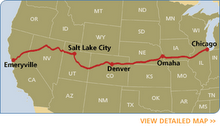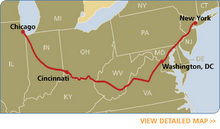
I am now leaving the state of Colorado and it was far more beautiful than I thought it would be. I hope to come back and take this ride again in the winter when the snow covers the canyon walls. My photography might even be improving. (Maybe not…) The train pulls in, just behind Coors Stadium so close you could catch foul balls, to downtown Denver, which is active and attractive with restaurants and lofts, popping up like pimples.

(Non-sequitar: We rode by building with a sign that read Coorstech. I just want to know -- are these the people that invented the can that tells you when the beer is cold because, seriously, if you can’t tell that the beer is cold, you don’t need to be drinking).
I think I can say that about the little I’ve seen of the Denver/Boulder area. It appears to have remained close to its roots. I visited a couple of cities, Boulder, Denver and a little town called Niwot. I appreciate the character of these cities that don’t seem to be interested in imitating the west or east coast.
I don’t know how you feel but I miss the distinct geographic character that distinguished the various regions of this country. I mean that architecture of the past was defined by necessity and convenience. Builders used the natural resources that were available and built homes to accommodate both the climate and the culture of those areas, so you get houses of stone and mortar with vast fireplaces and mudrooms in one area and frame and wood houses with wrought iron railings, high ceiling with woven reed fans in the center in others. You could tell where you were just by looking at the buildings.
Today, easy access to resources and shipping plus capitalism means replication, so the homes in Arizona aren’t that much different than homes in California or Missouri, which I guess is a good thing (though I can’t think why). Around every corner is the same set of stores (large affordable retail store – insert, Kohl’s, Target, Wal-Mart, next to a multiplex – insert sequel or remake of mediocre television show here, next to bank, next to chain restaurant, insert Claim Jumper, Mimi’s Café, Olive Garden, etc. here) I ain’t gonna lie; I like shopping. I contribute to the gross national product as much as the next person (seriously, maybe more) but wouldn’t it be nice to actually go somewhere that felt different, looked different, that reflected its roots. Isn’t part of the attractiveness of a place like New Orleans is the beautiful Spanish colonial homes or the row houses in Boston? I know, I know -- the plumbing and the closet space leaves a lot to be desired but can’t we update without turning every block into McDevelopment? My point is that they seem to be aware of that here. The homes I’ve had the pleasure of seeing and passing are new and still maintain the character that I think defines this west – the cragginess and solidity of the Rockies that surround it and it was a pleasure to see.
The people are probably some of the nicest I have ever encountered as a traveller. I don’t mean friends of friends, ( who were also nice and generous in spirit, as well) I mean complete strangers who went out of their way to be helpful and friendly, like the gentlemen who had just disembarked the train and saw me struggling up the ramp with my streamer trunk sized suitcase and offered his help. He walked with my suitcase all the way back to the platform and presented me to the attendent. I have no idea where he needed to go but he went out of his way for me. Several people at a convenience store outside of Denver assisted my friend and me when we lost our way. When the clerk couldn’t interpret the Yahoo directions we had gotten any better than we could, she got the manager to call the museum to get the directions. People just don’t do that.
Speaking of museums, I visited the Colorado Black West Museum. (Tip: Don’t trust Yahoo directions. It’s not hard to find but the directions are unnecessarily complicated. Call for directions or take the light rail which stops across the street). It’s housed in a small house in the Five Points area of Denver, well maintained, containing photographs, and memorabilia of black settlers, cowboys and prominent black citizens of Colorado’s past.
 Exhibits also highlight the Buffalo Soldiers, Tuskegee Airmen and the Bill Pickett Rodeo which still tours the country. Shay, the curator, provides a history of the building itself and the museum’s founders. (I won’t spoil it by telling you.) He is friendly and man with locks twisted around the top of his head and several piercings. Growing up in a predominantly white nieghborhood, when he played cowboys-and-Indians, he was always the Indian because cowboys were white. Coming to Colorado was a revelation for him and he shares his enthusiastic discovery with the public. (Ask him about his dogs, Biggie, Bebe, Baby and Lil’ Kim.)
Exhibits also highlight the Buffalo Soldiers, Tuskegee Airmen and the Bill Pickett Rodeo which still tours the country. Shay, the curator, provides a history of the building itself and the museum’s founders. (I won’t spoil it by telling you.) He is friendly and man with locks twisted around the top of his head and several piercings. Growing up in a predominantly white nieghborhood, when he played cowboys-and-Indians, he was always the Indian because cowboys were white. Coming to Colorado was a revelation for him and he shares his enthusiastic discovery with the public. (Ask him about his dogs, Biggie, Bebe, Baby and Lil’ Kim.) I didn’t find out much about the porters there. I didn’t expect to and I didn’t mind. I see that some of what I learned might be useful and I imagine it being incorporated into the novel somehow. I might use some of this as inspiration for another novel. Several novels have already been written about blacks who came to settle the West and created all-black townships – Paradise by Toni Morrison,, as well as, Black Wallstreet, but there’s always room for one more.
(Non-sequitar – I wonder why “Deadwood Dick,” who I believe visited Rev. Al Sharpton’s hairdresser, was never featured in the series, now canceled by HBO. Hmmmm…)
The night ride was filled with storms. There was little thunder I could hear over the noise of the rails, but I could see the lightning over the fields and rain crisscrossed my window. I fell asleep, glad that I was inside.





No comments:
Post a Comment
Post a comment. Thank you.